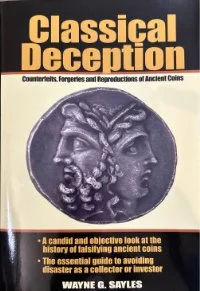Wayne G. Sayles:
Classical Deception is a detailed and accessible exploration of the long history of counterfeit ancient coins and the methods by which they are produced, detected, and sometimes unwittingly circulated within the numismatic world. Designed for collectors, students of antiquity, and museum professionals alike, the book traces forgery practices from antiquity to the modern era, showing that imitations have accompanied genuine coinage for as long as coins have existed. Sayles examines a spectrum of deceptions — from ancient contemporary counterfeits meant to pass in daily commerce, to the sophisticated modern forgeries that challenge even seasoned experts.
A substantial portion of the book profiles well-known forgers, documenting their techniques, motives, and the specific pieces they produced. Sayles pays particular attention to the prolific work of modern reproduction artists, including Peter Rosa, whose replicas are widely encountered and often misunderstood by beginning collectors. More than 200 photographs allow readers to visually compare authentic coins with their deceptive counterparts, highlighting telltale markers in style, fabric, metallurgy, and die workmanship.
Sayles also introduces the scientific and observational tools available to detect fakes — from simple weight measurement and magnified study of surfaces to metallurgical testing, microscopy, and imaging technologies. Throughout, he emphasizes practical guidance: what warning signs to look for, how to assess provenance, and how to avoid costly errors in the marketplace.
Ultimately, Classical Deception serves both as a cautionary manual and as a historical study of ingenuity, fraud, and craftsmanship. It equips the reader to navigate the hazards of collecting while deepening appreciation for the authentic artistry of ancient coinage.







